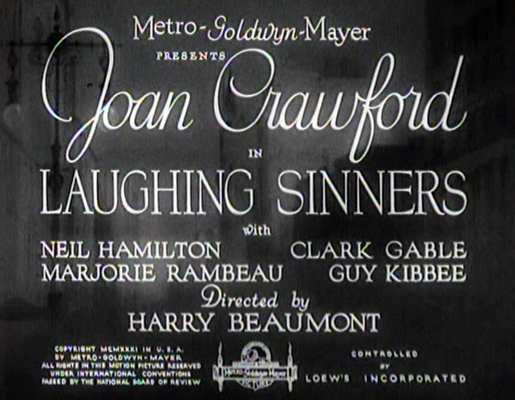
Laughing Sinners
1931

Critics' Reviews • Our Reviews • Movie Posters • Lobby Cards • Misc. Images
Click here to see photos from the film.
US release: 5/30/31.
VHS release: 7/21/93. Warner Archive DVD release: 3/23/09. Cast: Joan Crawford (as "Ivy Stevens"), Neil Hamilton, Clark Gable, Marjorie Rambeau, Guy Kibbee, Cliff Edwards, Roscoe Karns, Gertrude Short, George Cooper, George F. Marion, Bert Woodruff. Credits: From the play "Torch Song" by Kenyon Nicholson. Continuity: Bess Meredyth. Dialogue: Martin Flavin. Director: Harry Beaumont. Camera: Charles Rosher. Editor: George Hively.
Film Summary: The Kenyon Nicholson play Torch Song was the source for the Joan Crawford vehicle Laughing Sinners. Crawford plays nightclub entertainer Ivy Stevens, who loses her zest for living when she's thrown over by her salesman sweetheart Howard Palmer (Neil Hamilton). At her lowest ebb, Ivy is befriended by Salvation Army captain Carl Loomis (yes, that's Clark Gable!). With her faith in God and Mankind renewed, Ivy becomes an "urban missionary," singing on street corners with Loomis and his flock. Alas, she falls from grace when she rekindles her romance with the now-married Howard. The conscience-stricken Ivy quits the Salvation Army, insisting that she's no longer worthy of the organization. But rather than accept her resignation, Carl turns in his uniform and collection plate and pledges eternal devotion to Ivy! And this all happens in a swift 71 minutes. ~ Hal Erickson, All Movie Guide
Notes: • The play upon which the movie was based, "Torch Song," opened on Broadway on 8/27/30. • The film began production in February 1931. • Two of the film's original titles included Complete Surrender (see Lobby Cards below) and The Torch Song (see the Misc. section below). (Joan would make an unrelated film called Torch Song in 1953, also co-starring Marjorie Rambeau.)
|
A.D.S. in the New York Times (1931)
Miss Crawford has seldom looked so radiantly alive and beautiful; she has tempered the intense and not a little self-conscious quality of her acting without hurting her vibrant and breath-catching spirit. In the cabaret scene she gets through her dancing scenes in excellent fashion and even manages a torch song called "What Can I Do?--I Love That Man!" very commendably. |
If you've seen Laughing Sinners and would like to share your review here, please e-mail me. Include a photo of yourself or avatar to accompany your review, a star rating (with 5 stars the best), and any of your favorite lines from the film.
|
Rating:
I recently re-watched Laughing Sinners (1931), the second collaboration between the Queen and King of Hollywood---Joan Crawford and Clark Gable. Apart from a few brief asides about the Great Depression, there are few heavy preoccupying themes. As with many 1930s Joan flicks, her character ("Ivy") is involved in a love triangle. Of a sort. This film is slightly different, because the contestants for Joan’s body and soul are Neil Hamilton (who decades later would cement pop culture immortality as Commissioner Gordon on the 60s Batman TV series) and Clark Gable, respectively. By normal Hollywood conventions, this would be no contest. But in this movie, Gable is cast as Carl---a straight-laced Salvation Army do-gooder (albeit with a slightly edgy criminal past) who is the male more interested in Joan’s soul than her body. As Joan buffs might know, after all of Joan's Sinners scenes were initially shot with John Mack Brown, the lack of sizzle between them was apparent and so the scenes were re-shot with Gable. Per the Spoto Joan biography, Joan promised to work overtime and weekends with Gable to shoot the new scenes for Sinners, by which time she had already started This Modern Age (where she was a blonde). (The re-shoot does explain something I wondered about in past viewings of this film: Is it my eyes or is Joan’s hair color changing every other scene?!) Sinners is 72 minutes of mostly escapism. In addition to the romance
angle, Joan dances and dresses up as the sexiest hillbilly/farmer in
Tinseltown history---complete with overalls that have tear-away leggings
to show her fabulous gams. Joan also entertains with her voice, singing a
nice rendition of “What Can I Do? (I Love the Man).” I can only think of two small things that I might have changed. First, I wish Clark’s Carl Loomis would have shown a macho streak earlier. Toward the end, he socks Neil Hamilton (Howard “Howdy” Palmer) after Howdy has not only thrown Joan/Ivy over for the boss's daughter but tries to entice her to reignite their relationship by being his mistress. Second, the final few minutes show Joan going back and forth very indecisively, changing her mind almost second by second. In real life, Joan would have washed that goober Howdy right out of her hair and got on with life. I don’t mind how Sinners turned out, but the denouement could have been a tad more fully developed. As this film was shot during the pre-Code era, I think they missed a few opportunities to add a little more spice to the final mix. One thing I love about Laughing Sinners
is the excellent supporting cast. As pointed out in Michael's review below,
these are A+ character actors from the studio system days. First of note is Guy
Kibbee, who rose to fame in the Broadway play from which Sinners is adapted.
Kibbee plays an old-time traveling salesman who has seen a thing or two-hundred in his day. His character injects required levity into the
film. Also
supporting Joan is Marjorie Rambeau, Ivy’s moxie-laden coworker/buddy, Ruby. (As mentioned in
Michael's review, Rambeau went on to earn an Oscar nomination for playing
Joan’s mom in 1953's Torch Song.
Another fun fact
indicating the inter-related world of Hollywood: Rambeau was once married to
Willard Mack, who wrote the screenplay for Joan's Old Clothes [1925]. And
Mack was also once married to Pauline Frederick, who played
Joan's mother in This Modern Age!) Also of note in the supporting cast is Cliff Edwards (aka "Ukulele Ike"; in The Hollywood Revue of 1929---Joan’s talkie debut---Edwards and his ukulele are featured). Roscoe Karns plays one of the good-time-Charlie traveling salesman who populate Sinners. Other familiar faces: Clara Blandick (Auntie ‘Em), Mary Ann Jackson (Our Gang shorts), Bert Woodruff (Billie Haines’ dad in the 1927 Joan/Billie silent, Spring Fever), and Karen Morley (who would rise to fame in the original Scarface next year). Harry Beaumont directs. He also directed Joan in her breakout film, 1928's Our Dancing Daughters, and a few others. One aspect that fascinates me about Laughing Sinners
is where Joan and Clark were in their respective lives. There are few
sparks flying (on screen, that is---off-screen was apparently another story!), like
in their later collaborations or even in their very first collaboration Dance, Fools, Dance (1931). Some reviews of Laughing Sinners
have thus suggested Gable was miscast. Viewing the film with 90+ years of
hindsight, perhaps this is so---but in 1931, the full Gable mystique was still in the
future (Clark doesn't even yet sport his trademark mustache). While Joan is a
full-fledged star here, Clark’s star is still only on the rise; he is perhaps
where Joan was 4 years
before, when MGM began pairing her with their top male stars---Haines, Novarro,
Chaney, Gilbertto---to raise her profile. In Sinners, MGM seems to be doing the samefor their new male contract player; in 1931 and 1932, aside from Joan, Gable
appeared with Norma Shearer, Greta Garbo, Barbara Stanwyck, Marion Davies, and---in the movie I think put him on the road to immortality,
Red Dust (1932)---Jean Harlow. In Sinners, his acting might
be a bit stiff, but Gable still must have been better than the
utilitarian John Mack Brown! In short: Strong cast from top to bottom. And a fun movie.
Rating:
The interest in this film is the rise of Miss Joan Crawford and the perfection and dedication of MGM as a factory dishing out art and entertainment to the masses and building up and supporting talent on all levels of filmmaking. The studio bosses loved the movies. Here in Laughing Sinners, you can see the growth and be a part of it. (Sorry, Johnny Mack Brown.)
This story is not new; why, I have friends seeing married men right now, and there are a few married men who want to see me. Folks, you just have to know what you want and then take your chances.
The film has that early talkie feeling. However, with that comes the last stage of the talkie changes: bringing in the folks from Broadway and the East (soon the Europeans will be coming to Hollywood and making more changes, the only good thing that came out of Hitler). And by that I mean those wonderful character actors: Roscoe Karns, Guy Kibbee (who has a good drunk scene), and Marjorie Rambeau -- can you beat her? She has a Gladys George quality and is hip and cool: Joan always lucked out in these early films with “Nice streetwise best girlfriends.” Twenty-two years later, Miss Rambeau would play Joan’s mother in Torch Song (which coincidently was the original name of this story), and she kept that same ” lovingly, gruff speak-her-mind” personality that would earn her an Oscar nomination for supporting actress -- what a woman!
George F. Marion works at the club Joan dances at, and he had the distinction of playing Garbo’s father the year before in Garbo’s first talking filmAnna Christie.
Neil Hamilton we all know as "Commissioner Gordon" from TV’s Batman in the 60s. He sparks low but is passable as a cad. Miss Crawford was lucky meeting Mr. Gable and being saved by him before she jumps off a bridge. (Neil was not worth it.)
This would be Gable's last role playing anything like a Salvation Army officer! It works somehow, and the stars are lovely and appealing together (he even cooks for Miss Crawford)! Miss Crawford looks radiant and sexy, especially in a few song-and-dance numbers; she is young and fresh and glowing. It is refreshing to see how youthful and carefree she was and could be. Her acting was beginning to register.
Harry Beaumont was an old hand at handling Miss Crawford, having directed her in the highly successful Our Dancing Daughters in 1928, which prompted MGM to give him the first sound musical to direct -- The Broadway Melody in 1929, for which he won the Oscar for Best Picture! He never went too much higher, but it is noticeable that he treats Miss Crawford in a professional and graceful manner.
No wonder this was one of Miss Crawford’s favorites. Every time I view this movie, she remains a beautiful spirit.
Rating:
Laughing Sinners (1931) is an underrated Joan film (snappily directed by Harry Beaumont, who also did other early Joan films like Our Dancing Daughters, Our Blushing Brides, and Dance Fools Dance) in the new realistic mode that MGM began featuring Joan in during 1930 and 1931---films like Our Blushing Brides, Paid, Dance Fools Dance, and Possessed that were a decided departure from Joan's string of girlfriend/party girl roles of the late '20s.
Joan is Ivy---a gambling, drinking, loyal nightclub entertainer madly in love with Howard (the rather stiff Neil Hamilton), a seedy, smooth-talking traveling salesman who almost immediately dumps her to marry a rich girl.
The initial nightclub scene of Sinners, when Ivy is still feeling her oats before she gets dumped, showcases Joan's versatility as a physical performer. She hoofs it up with a beard and fake nose (!) in a weird hillbilly number, which morphs into a more accessible frisky modern dance, followed by a slower torch song (this last cleverly and sadly interspersed with shots of the regretfully hard-hearted Howard composing a goodbye note...on the back of a menu).
But the best part of the movie is the showcasing of Joan's acting---as a giddily lovestruck then cast-off then rescued then backsliding showgirl, she manages to be variously a bit crude and sarcastic, as well as hurt and sad and wild and grateful, all without displaying overt dramatics.
The writing for the film is interesting, too: When Ivy gets to know her Salvation Army rescuer Carl (Clark Gable), he tells her he has been in prison for 2 years. She responds, "Did they railroad you or something?" but he honestly (and refreshingly) says, "No...I got what was coming to me." And when a kid at a park cornily asks Ivy to sing "London Bridge," the club-girl Ivy, rather than pseudo-heartwarmingly acquiescing, replies instead, "'London Bridge' is not my specialty. I sing red-hot blues." Sinners has a lot of un-sugarcoated touches like this, including a not-overdone scene of a girl unrevivable after a night of partying, as well as the supporting cast of unapologetically spirited-yet-rough characters (including Marjorie Rambeau, later to co-star as Joan's mother in Torch Song, and the group of wise-cracking salesmen that Howard runs with). The writing and characterizations add color to the picture, showing both the depressing and the exciting aspects of the fast-living lifestyle that Ivy must battle with, without overly moralizing about them.
And that "not moralizing" is a pretty good trick, considering that Ivy's hero is a Salvation Army officer, of all people. Ivy meets Gable's Carl as she's about to jump off a bridge in despair over Howard---the premise seems over-the-top, but the results are handled well. In his second film with Joan, Gable is a good-natured and charismatic preacher who looks sexy yet comforting in both his off-duty sweater and apron as he cooks scrambled eggs for Ivy. Since Gable had just recently appeared on the Hollywood scene in a few gangsterly tough-guy roles (including the Joan-film just prior to Sinners, 1931's Dance Fools Dance), his character here is decidedly against type but well-acted; he definitely makes Ivy's eventual decision to go good believable.
Sinners seems like something of a lighter-weight precursor to 1932's Rain---in both, Joan plays a realistically world-weary/wary wild-child character who's also genuinely open to sincere alternatives to her former lifestyle that had made her rather unhappy. (Here, Gable's honest Carl provides the impetus that the hypocritical Reverend Davidson obviously could not!)
Favorite Lines:
Ivy to Carl: Thanks for saving my life. I'll drop a quarter in your tambourine sometime.
Friend to Howard, giving instructions on writing Ivy a goodbye note: Tell her you still love her...No, don't put that in writing!
|
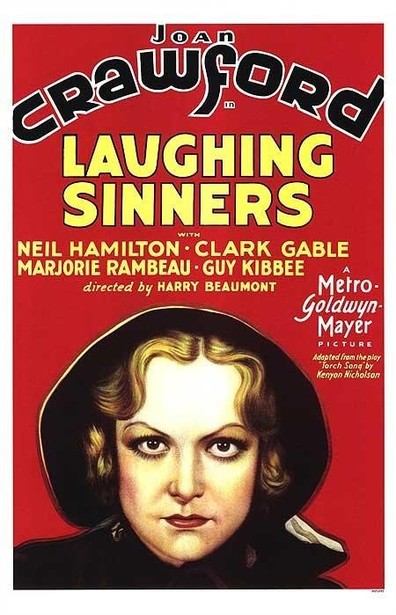
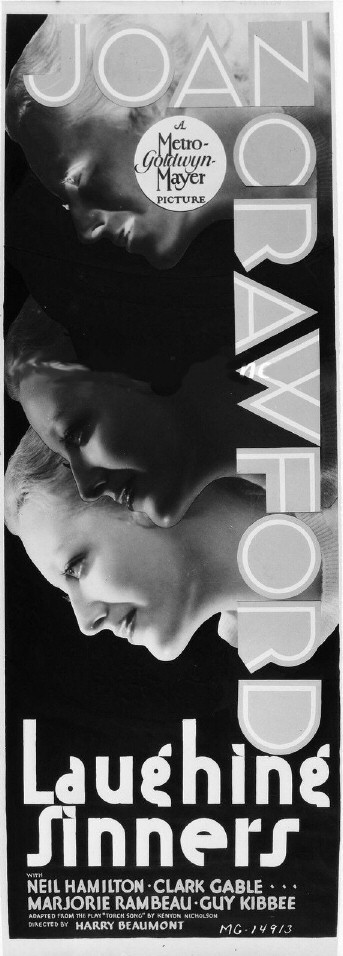

Above: A lobby card for Laughing Sinners pre-name change and pre Johnny Mack Brown's replacement with Clark Gable.
Below: US lobby cards.


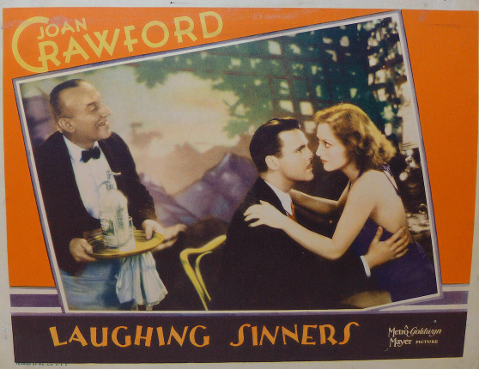
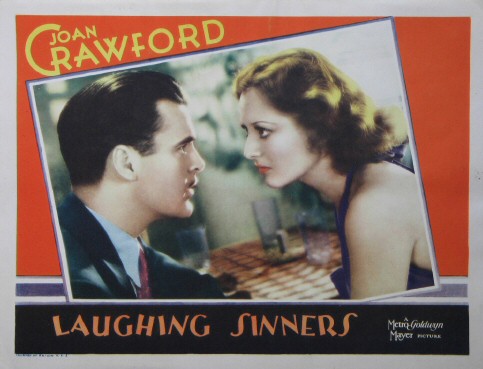
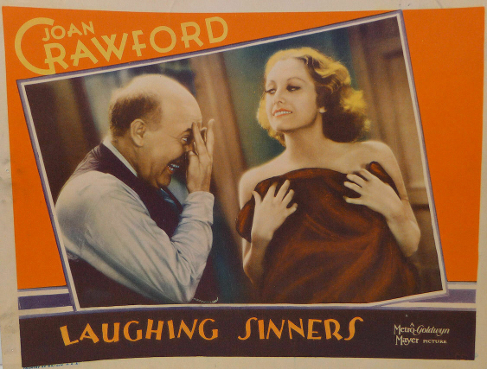
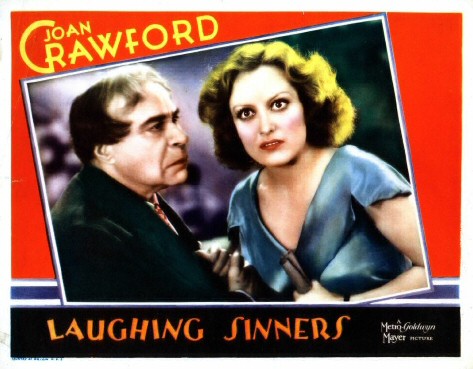

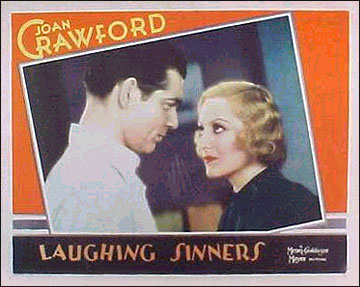

Above: Sheet music for Laughing Sinners, with the initial name of the film, Torch Song.
Below: Program centerfolds.

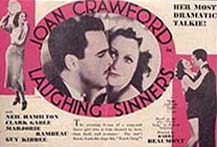
Below: UK and US glass slides
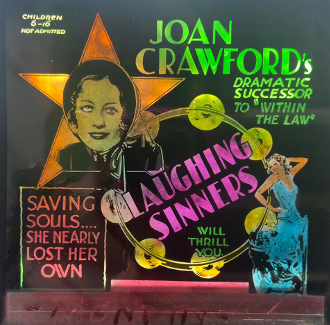
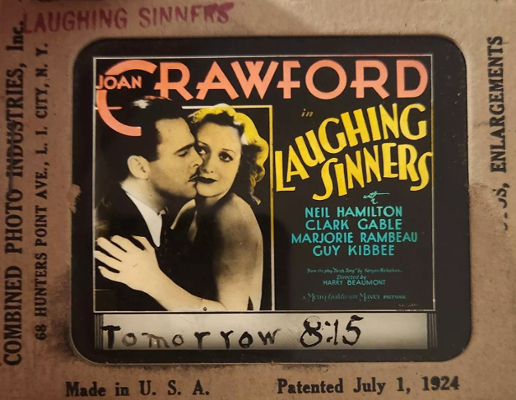
Below: Four US newspaper ads

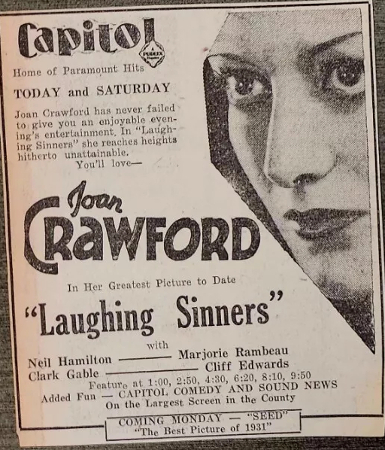
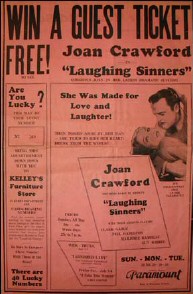

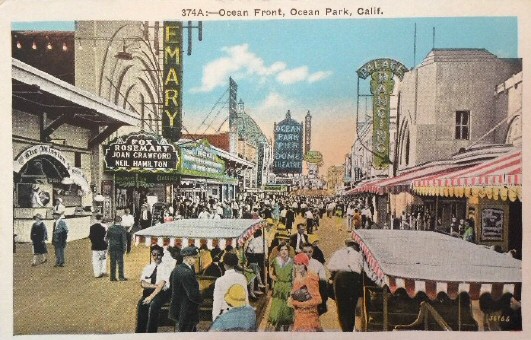
Above: A 1931 postcard from Ocean Park, California, featuring a Laughing Sinners marquee with Joan and Neil Hamilton at left.